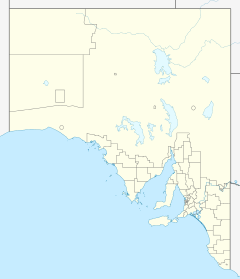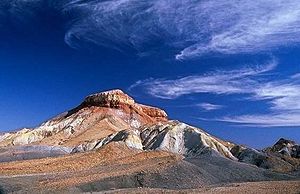Arckaringa Station facts for kids
Arckaringa Station is a very large farm in South Australia. It's a special kind of farm called a pastoral lease. This means it's a huge area of land used for raising animals.
It used to be a sheep station, raising sheep for wool or meat. Now, it's a cattle station, where cattle are raised.
Contents
Where is Arckaringa Station?
Arckaringa Station is located in the middle of South Australia. It is about 83 kilometers (52 miles) southwest of a town called Oodnadatta. It is also about 117 kilometers (73 miles) north of Coober Pedy.
What Does the Land Look Like?
Most of the land at Arckaringa Station is made up of flat, stony plains. These are called gibber plains. There are also areas where creeks sometimes flood. The land also has rocky hills and cliffs.
A creek called Arckaringa Creek flows through the property. It is an ephemeral creek. This means it only flows after it rains. Both the station and the creek are named after Mount Arckaringa. This rocky hill is in a colorful area called the Painted Desert. The name "Arckaringa" comes from the Aboriginal people. Its exact meaning is not known today.
How Big is Arckaringa Station?
Arckaringa Station is very large. It covers an area of about 2,745 square kilometers (1,060 square miles). That's bigger than many cities!
How Many Animals Can It Hold?
The station can raise up to 2,100 head of cattle. The area usually gets about 139 millimeters (5.5 inches) of rain each year. The animals get their water from 17 special wells called bores. They also drink from 20 dams that collect rainwater.
History of Arckaringa Station
Arckaringa Station was started before 1908. Back then, it was about 1,000 square miles (2,590 square kilometers) in size. It had about 2,000 sheep.
Early Years and Challenges
In 1883, a government well was dug on the Arckaringa Creek. This well helped water animals along a path used for moving livestock. This path ran through the area from the Musgrave Ranges.
By 1912, the station was smaller, about 432 square miles (1,119 square kilometers). The owner, Mr. F. C. Staer, lost almost 400 sheep that year. This was because of a very dry season. The government planned to dig another well to help.
Good Times and Rain
In 1913, Arckaringa Station had a good season. The grass grew very tall, up to 12 feet (3.7 meters) high! Samples of this tall grass were sent to Adelaide for study. Mr. F. C. Steer still owned the property and was raising sheep.
In 1925, Alexander McLeod owned Arckaringa. The area received heavy rains that year. In 1935, there were even more heavy rains. Arckaringa got 3 inches (76 millimeters) of rain in just one day! The creek flooded and became over 2 miles (3.2 kilometers) wide. It filled all the waterholes and dams on the property.
Recent Discoveries
In 2000, a new plant species was found on the station. It was named Olearia arckaringensis. This plant is a type of Daisy-bush. About 200 of these plants were found during a study.
The station faced a drought in 2004. A drought is a long period with very little rain.
In April 2013, the land that makes up Arckaringa Station was officially named 'Arckaringa'. This made it a recognized place on maps.
See Also
- List of pastoral leases in South Australia



